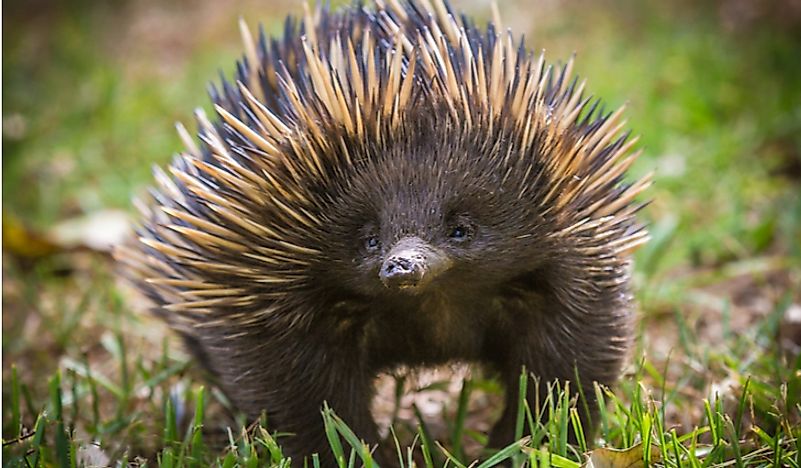Where do Echidnas Live?

While most animals have an ingrained fear of fire, the short-beaked echidnas (Tachyglossus aculeatus) tend to sleep through episodes of fire, entering a state of torpor during such incidents. These echidnas are easily distinguished by their cream-colored spines that coat their entire dorsal surface as well their tiny tail. Honey to dark reddish-colored fur in between the spines insulates the animal against temperature extremes. The ventral surface of the body is covered by bristles and fur. The spines of the echidna are actually modified hairs, composed of keratin, that can grow up to lengths of 50 millimeters. The animals attain a length of about 30 to 45 centimeters and weigh about 2 to 7 kilograms. The neck of the echidna is barely visible under the spines. It has a pair of small bright eyes at the base of its muzzle. It can open its toothless jaws for only a short distance, just enough to allow its 15- to 18-centimeter long sticky tongue to flick in and out.
4. Diet
The short-beaked echidnas prefer ants and termites as their primary source of food but also feed on insect larvae, worms, and grubs. They use their fore paws to dig into the ground or termite mounds in search of prey. Once they detect prey, they flick out their tongues, covered with sticky mucus, to attach the prey to the tongue. They then immediately flick in their tongue, allowing no time for the prey to struggle and escape. Though their jaws are toothless, the hard pads at the roof of their mouth and base of their tongues smash the prey which is then ingested. During the feeding process, the echidnas flick out their tongues several times in a rapid fashion which is evident from their specific name Tachyglossus which means “fast tongue”.
3. Habitat, Range, and Fire-Surviving Abilities
The short-beaked echidnas have a wide range and distribution. They occupy habitats as varied as forests, meadows, snow capped mountains, rocky landscapes and even deserts. They are one the distinct animals of Oceania and are found in large parts of Australia. In Tasmania, the subspecies T. aculeatus setosus is found while the subspecies T. aculeatus multiaculetaus thrives in the Kangaroo Island of South Australia. One of the most interesting features of these echidnas is their ability to easily survive wildfires by entering a stage of torpor. In 2013, when a massive forest fire raged across the east Australian forest of Warrumbungle National Park, scientists noticed that the short-beaked echidnas were among the few wild survivors of the forest. In-depth studies revealed that these echidnas are able to face fires by entering an inactive state where they lower their body temperatures significantly to reduce their energy needs and thus sleep through the entire catastrophic event, hidden in their underground burrows, waiting for the fire to stop. Most wildlife deaths from wildfires are caused when trees fall on animals or they get trapped in the fire while foraging for food. By entering the torpor state in their hiding place, the short-beaked echidnas are able to overcome both these threats.
2. Social Behavior
Short beaked echidnas do not have fixed burrows or home territories and can be found wandering over areas between 21 and 93 hectares. They are usually active during the day but since they are unable to tolerate heat, during the warm days, they become nocturnal or crepuscular. These echidnas are endothermic, maintaining an optimal temperature of around 32° Celsius. These animals also hibernate during winters and undergo brief periods of torpor throughout the year.
1. Reproduction and Lice Cycle
The short-beaked echidnas mate between May and September when both males and females produce a strong musky odor for attracting mates. A single female is joined by a train of prospective males in a courtship ritual that lasts for about 4 weeks. During the gestation period of around 21 to 28 days, the female digs a burrow on the ground for nesting and at the end of gestation the egg is transferred from her cloaca to an abdominal pouch which she develops during the breeding season. Within 10 days the hatchling, now known as a puggle, emerges from the egg and climb along the mother’s body in search of milk areolae from where it sucks the milk of its mother. The mother often leaves the puggle in the burrow while she forages for food elsewhere. By about 180 to 205 days, the puggle is ready to leave the burrow and since then loses contact with its mother.







